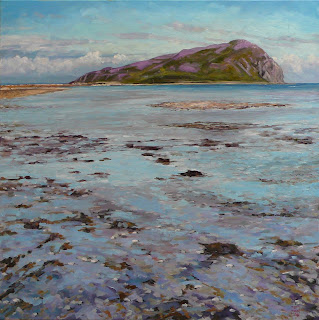Saturday, April 13, 2013
The finished work
Standing before the finished work the corner of my mouth raised in an involuntary smile I allowed the imp of contentment to rest on my shoulder a while as together we looked at the image. A title comes to mind, this 80x80 oil is from a sketch done at Ghearadha Beach a few minutes walk from my house on the Isle of Lewis, looking inland to the contrasting brown heather and beige bracken up on the escarpment and down to the beach where I stand with my “back to the sea”, fresh water from the loch seeping out in a great fantail beneath my feet. My normal reaction is to search for any glaring mistakes; difficulty of composition, correctness of drawing, and discrepancy in colour or simply something not quite finished. How does one know that a painting is finished when Lucien Freud would take a hundred hours or more while another will run the perfect trace across the canvas and declare it finished? All is down to the individual artists and for me it’s a point where I know if I continue the painting I will risk loosing rather than gaining. That single perfect line can be sublime and in its execution it sums up all that is essential to the subject, the nub of the matter, the ultimate simplification or abstraction that still retains within it all that is required to recreate that image. I have always enjoyed paintings that look as if they have been easy to execute rather than something laboured. An easy light touch results in a level of spontaneity that imparts a feeling of lightness and joy, it may also result in transporting me back to the place where I feel the breeze and smell the salt fresh air. On the rare but none the less enjoyable occasions when I walk with friends through a landscape I note also the difference in what we see. My eye can be equally drawn to the curve of a bleached rabbits jaw bone tangled within the vivid yellow trefoil or the white dart like gannets dropping from an inky blue sky way out at sea as well as absorbing its enormity and passage of time within a landscape that holds me there truly looking and ready to draw. It is important that I find that tranquillity, rage, brilliance or brutality within the landscape and then having passed through me I can impart that emotion with paint and brush. “Paint it as you see it and always push the boundaries” is what I try to tell myself, whether that be in size, format, colour or subject matter. Being a rational romantic is not always easy when wielding a brush full of paint.
There are times when that stopping point slips by and I fall into correction and overworking as was the case with the second done on the same format from a collection of drawing of the island of Davaar that my parents once owned. A confusion of perspective marred the first effort and even after several corrections the following day they left me just as disappointed with an image that was not imparting what I felt when crossing over the Dhorlin. A radical change was required and so I removed much of the foreground and continued to repaint.
Subscribe to:
Posts (Atom)


